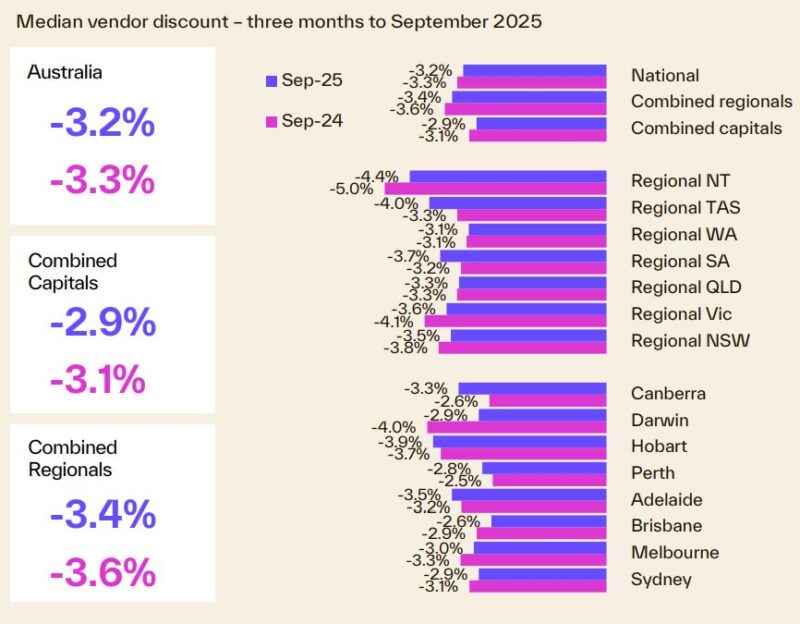
Key takeaways
Most property investors are wondering when the next rate cut is coming.
Since the latest CPI figures came in slightly higher than most economists expected, our 4 major banks revised their cash rate forecasts.
Three banks expect just one more cut in the cycle.
Westpac is now the outlier, still forecasting three further cash rate cuts in November, February and May. However, its economics team said a November cut was “far from assured”.
This week, Cotality also reports that:
*Sydney property prices increased 0.1% over the last week, increased 0.6% over the last month and are 3.4% higher than they were 12 months ago.
*Melbourne property prices increased 0.2% over the last week, increased 0.6% over the last month, and increased 2.3% compared to 12 months ago.
*Brisbane property prices increased 0.3% over the last week, increased 1.3% over the last month and are 9.5% higher than they were 12 months ago.
Overall, Australian capital dwelling prices increased 0.8% over the last month and are now 4.7% higher than they were 12 months ago.
Clearly, the property cycle is mov
There were 2,613 homes taken to auction across the combined capitals last week, up 33.5% on the previous week when auction activity was impacted by a long weekend in four of the eight states and territories (1,958).
The combined capital city preliminary clearance rate rose to 73.0% last week – the highest in three weeks.
This current property cycle has been driven by an undersupply of good properties relative to current demand pushing up property values and rents there was nothing to suggest there will be any significant change in the near future.
Unfortunately, the undersupply properties is going to persist for some time with all commentators agreeing that there is no way we're going to hit the housing construction targets required to meet our demand.
Most property investors are wondering when the next rate cut is coming.
Since the latest CPI figures came in slightly higher than most economists expected, our 4 major banks to revise their cash rate forecasts.
Three banks expect just one more cut in the cycle.
Westpac is now the outlier, still forecasting three further cash rate cuts in November, February and May. However, its economics team said a November cut was “far from assured”.
Lucy Ellis, Westpac chief economist, explained…
“ It’s almost certain that RBA has not yet decided whether or not to cut the cash rate at its November meeting.
If the meeting were held today, they would keep rates on hold, awaiting further data.
Several potentially decisive data releases are due before the actual meeting, though, including the September labour data and the full quarterly CPI. Until then, we need to hold two possible futures in mind: hold or cut.
If the RBA does hold the cash rate steady at the November meeting, the chance increases that it cuts in February and ends up at a trough of 2.85% rather than something higher.”
On the auction front this week... selling season heats up across combined capitals
From a volume perspective, the selling season is heating up, with 2,662 homes taken to auction last week, the highest weekly number of auctions since the week ending June 1st, 2025 (2,918).
The preliminary auction clearance rate reached a fourweek high, rising to 73.8% last week.
This week, Cotality also reports that:
- Sydney property prices increased 0.1% over the last week, increased 0.6% over the last month and are 3.4% higher than they were 12 months ago.
- Melbourne property prices increased 0.2% over the last week, increased 0.6% over the last month, and increased 2.3% compared to 12 months ago.
- Brisbane property prices increased 0.3% over the last week, increased 1.3% over the last month and are 9.5% higher than they were 12 months ago.
Overall, Australian capital dwelling prices increased 0.8% over the last month and are now 4.7% higher than they were 12 months ago.
Clearly, the property cycle is moving on but our markets are very fragmented.
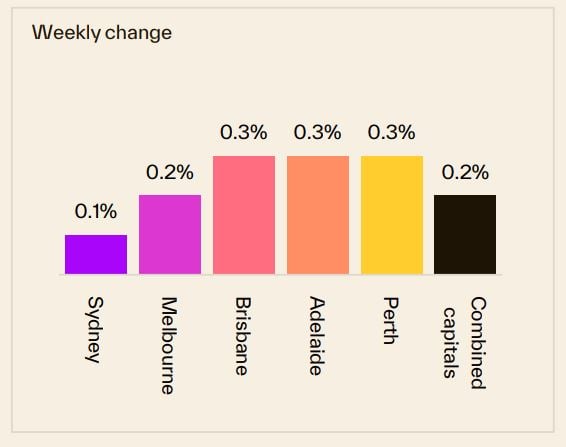
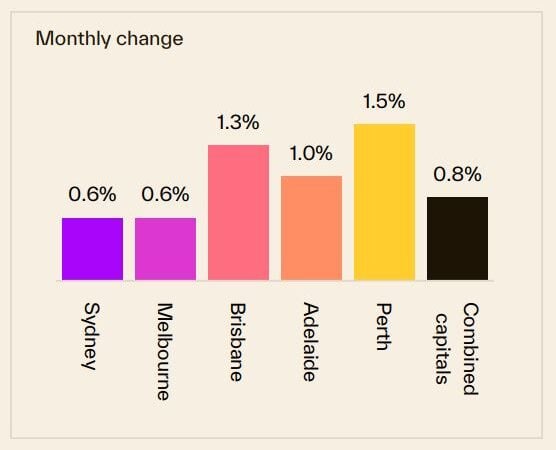
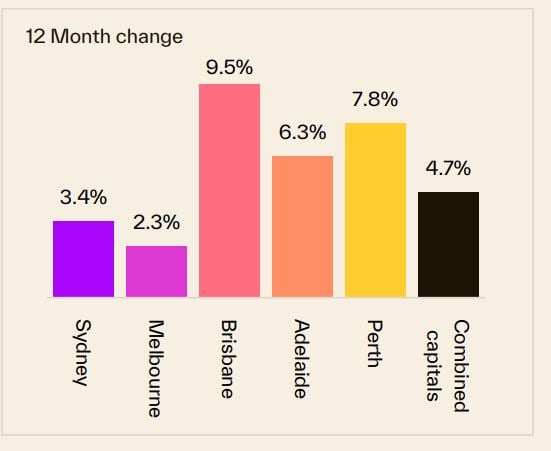
Source: Cotality October 20th 2025
Of course, these are "overall" figures - there is not one Sydney or Melbourne or Brisbane property market.
And various segments of each market are performing differently.
At the beginning of this cycle the upper quartile of the market lead the upswing but last year the lower quartile across every capital city recorded a stronger outcome for housing values relative to its upper quartile counterpart.
The following chart shows how various segments of each capital city market are performing differently with median-priced properties performing well.
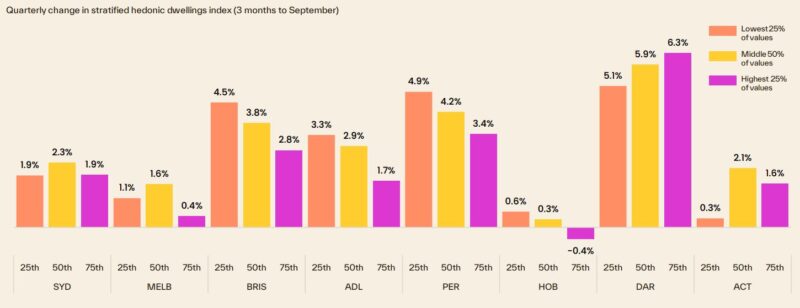
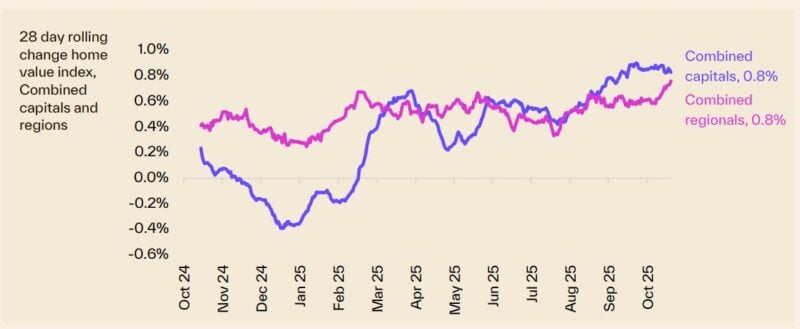
To help keep you up-to-date with all that's happening in property, here is my updated weekly analysis of data and charts as of 20th October 2025 provided by SQM Research, Cotality, and realestate.com.au.
Current property asking prices
Property asking prices are a useful leading indicator for housing markets - giving a good indication of what's ahead.
Here is the latest data available:
Sydney
| Property type | Price ($) | Weekly Change | Monthly Change % | Annual % change |
|---|---|---|---|---|
| All Houses | 2,104,831 | -3.832 | 1.0% | 8.7% |
| All Units | 873,618 | -3.218 | -0.2% | 3.8% |
| Combined | 1,602,678 | -3.582 | 0.7% | 7.3% |
Source: SQM Research
Melbourne
| Property type | Price ($) | Weekly Change | Monthly Change % | Annual % change |
|---|---|---|---|---|
| All Houses | 1,297,075 | -1.875 | -0.5% | 3.9% |
| All Units | 652,529 | 0.771 | 1.7% | 6.7% |
| Combined | 1,093,156 | -1.038 | -0.1% | 4.2% |
Source: SQM Research
Brisbane
| Property type | Price ($) | Weekly Change | Monthly Change % | Annual % change |
|---|---|---|---|---|
| All Houses | 1,308,668 | 7.270 | 2.0% | 11.0% |
| All Units | 779.748 | -2.358 | 1.2% | 17.5% |
| Combined | 1,175,451 | 4.845 | 1.9% | 11.9% |
Source: SQM Research
Perth
| Property type | Price ($) | Weekly Change | Monthly Change % | Annual % change |
|---|---|---|---|---|
| All Houses | 1,180,443 | 11.156 | 0.8% | 10.8% |
| All Units | 680,306 | 3.484 | 0.6% | 19.1% |
| Combined | 1,049,276 | 9.144 | 0.8% | 12.0% |
Source: SQM Research
Adelaide
| Property type | Price ($) | Weekly Change | Monthly Change % | Annual % change |
|---|---|---|---|---|
| All Houses | 1,058,644 | -4.644 | -0.5% | 10.6% |
| All Units | 584,892 | 0.908 | 1.8% | 26.0% |
| Combined | 973.361 | -3.644 | -0.2% | 12.1% |
Source: SQM Research
Canberra
| Property type | Price ($) | Weekly Change | Monthly Change % | Annual % change |
|---|---|---|---|---|
| All Houses | 1,277,712 | 15.025 | 2.5% | 9.0% |
| All Units | 585,505 | -0.018 | 0.7% | -2.1% |
| Combined | 1,017,779 | 9.376 | 2.1% | 5.8% |
Source: SQM Research
Darwin
| Property type | Price ($) | Weekly Change | Monthly Change % | Annual % change |
|---|---|---|---|---|
| All Houses | 769,713 | -10.713 | -1.2% | 13.7% |
| All Units | 442,847 | 1.778 | 0.5% | 14.9% |
| Combined | 641,193 | -5.802 | -0.7% | 14.0% |
Source: SQM Research
Hobart
| Property type | Price ($) | Weekly Change | Monthly Change % | Annual % change |
|---|---|---|---|---|
| All Houses | 855,045 | 0.227 | 0.6% | 6.4% |
| All Units | 489,241 | -0.241 | 0.7% | 1.8% |
| Combined | 799,226 | 0.156 | 0.6% | 5.9% |
Source: SQM Research
National
| Property type | Price ($) | Weekly Change | Monthly Change % | Annual % change |
|---|---|---|---|---|
| All Houses | 1,036,402 | 4.950 | 1.2% | 8.9% |
| All Units | 613,462 | -0.906 | 1.2% | 8.9% |
| Combined | 944,700 | 3.680 | 1.2% | 8.8% |
Source: SQM Research
Cap City Average
| Property type | Price ($) | Weekly Change | Monthly Change % | Annual % change |
|---|---|---|---|---|
| All Houses | 1,514,022 | -2.039 | 0.4% | 7.7% |
| All Units | 758,366 | -2.329 | -0.2% | 7.0% |
| Combined | 1,288,370 | -2.126 | 0.3% | 7.4% |
Source: SQM Research
The value of property asking prices as a leading indicator for housing markets is quite significant.
In fact it's more valuable than median prices which can be quite misleading.
Let's delve into why this is the case and how it impacts the real estate market.
- Early Market Sentiment Indicator: Asking prices often reflect the current sentiment of sellers in the real estate market.
If sellers are confident, they might set higher asking prices, anticipating strong demand.
Conversely, if sellers are uncertain or perceive a market downturn, they might lower their asking prices to attract buyers.
This makes asking prices a real-time indicator of market sentiment, often preceding changes in actual sales prices. - Predictive of Future Price Trends: Trends in asking prices can be predictive of where the actual property prices are headed.
For example, a consistent rise in asking prices over a period can signal an upcoming rise in transaction prices. - Impact of Economic Factors: Economic factors such as interest rates, employment rates, and broader economic health influence asking prices.
For instance, changes in the Reserve Bank of Australia's policies or shifts in the job market can quickly reflect in the asking prices, providing insights into how these factors are influencing the housing market. - Regional Variations: In a diverse market like Australia's, asking prices can also provide insights into regional disparities.
For instance, the property markets in Melbourne and Sydney might behave differently from those in Brisbane or Perth. Asking prices can give early indications of these regional trends. - Influence of Supply and Demand: Asking prices are also a response to the balance of supply and demand in the market.
In areas with limited supply and high demand, asking prices tend to be higher and vice versa.
However, it's important to note that while asking prices are a valuable indicator, they should not be used in isolation.
Other factors like actual sales prices, time on the market, auction clearance rates, and economic conditions also play crucial roles in understanding the property market dynamics.
READ MORE: The latest median property prices in Australia’s major cities
Last weekend's auction report
Selling season heats up across combined capitals
The preliminary auction clearance rate reached a fourweek high, rising to 73.8% last week, up from 73.0% the
previous week (revised down to 68.2% on final numbers) and a recent low of 71.4% through the last week of September.
From a volume perspective, the selling season is heating up, with 2,662 homes taken to auction last week, the highest weekly number of auctions since the week ending June 1st, 2025 (2,918).
Auction activity is set to rise further, with more than 3,200 homes scheduled to go under the hammer this week before dropping back to around 2,180 next week as Melbourne pauses for the Spring Racing Carnival.
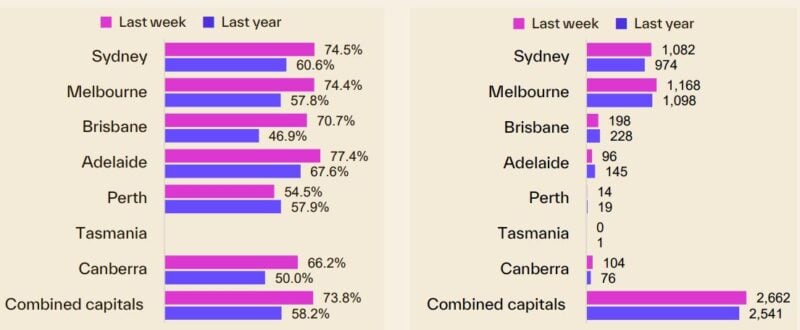
Across the capital cities, Melbourne hosted the most auctions, with 1,168 homes taken to market, down 6.5% from the previous week when 1,249 homes were auctioned.
The preliminary clearance rate came in at 74.4%, the highest result in four weeks but still well below the spring high of 78.6% recorded over the week ending September 21st.
1,082 auctions were held in Sydney last week, a 9.5% rise on the previous week (988).
This is not only the second highest volume through spring so far, but also just the fourth time this year where Sydney has hosted more than 1,000 auctions.
The preliminary clearance rate held up well under the higher volume, coming in at 74.5% last week, a four-week high.
Brisbane led the smaller capitals for the number of auctions held, with 198 homes going under the hammer last week, the third highest volume of auctions held so far this year.
The preliminary clearance rate of 70.7% was the highest in five weeks.
104 homes were auctioned in the ACT last week, down 1.9% from the week prior.
66.2% have been reported as successful so far, up from 61.5% the week prior but well down on the spring high of 81.3% recorded over the week ending September 21st.
96 homes went to auction across Adelaide last week, level with the previous week. 77.4% of auctions have reported a positive result so far.
Only 14 auctions were held across Perth last week, while there were no auctions in Tasmania.
Our rental markets
The national vacancy rate slipped to a new record low of 1.4% in September, with only 1.1% of Australian units and 1.7% of houses estimated to be vacant and available for lease in September.
The renewed downtrend in rental vacancies has been accompanied by a re-acceleration in rental growth. The national Rental Index rose half a per cent in seasonally adjusted terms through September, taking the quarterly change to 1.4%, the highest since June last year.
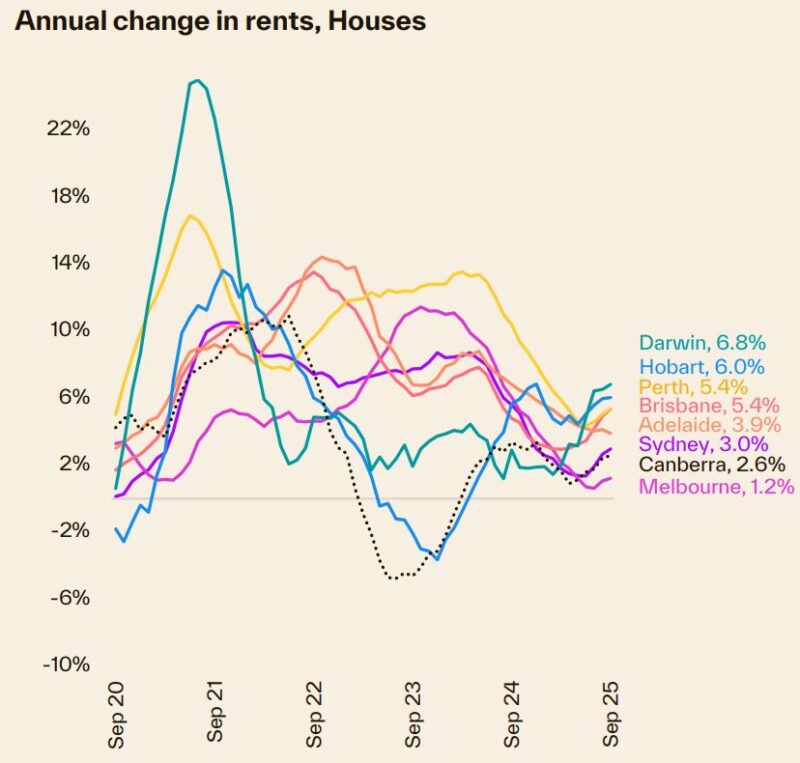
Among the capitals, Darwin recorded the strongest quarterly increase in rents, up 2.9% in seasonally adjusted terms, followed by Hobart with a 1.9% rise and Perth, up 1.7%.
Adelaide (+0.4%) and Melbourne (+0.8%) recorded the mildest rental increases over the past three months.
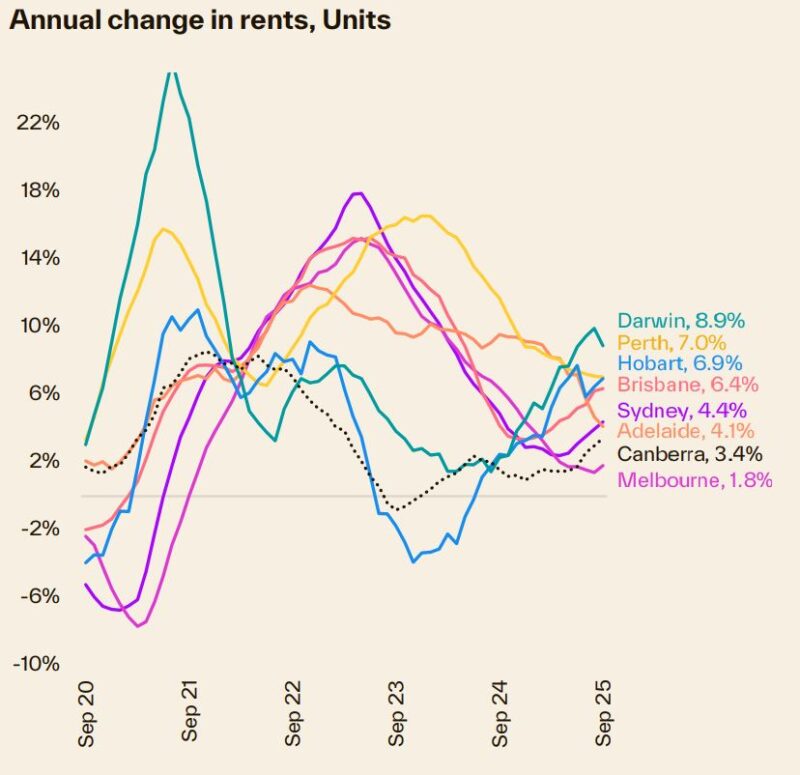
Although rental growth has rebounded, we are once again seeing home values rising at a faster pace than rents, which has seen gross rental yields reduce a little in recent months.
Nationally, gross rental yields came in at 3.65% in September, the lowest since November last year.
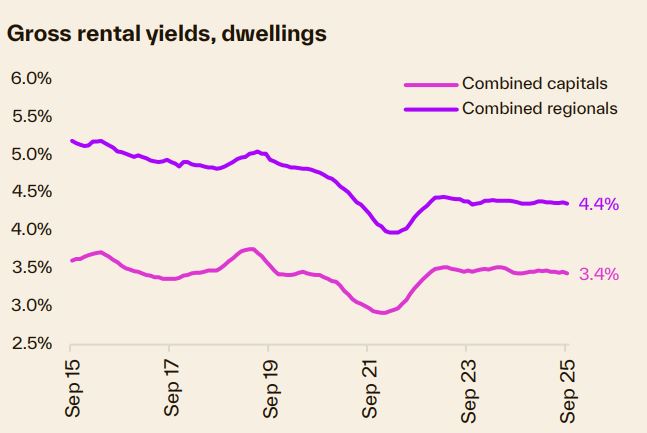
Sydney
| Property Type | Rent ($) | Weekly change | Monthly change | 12 Months change |
|---|---|---|---|---|
| All Houses | $1,104.04 | 4.96 | 1.7% | 5.9% |
| All Units | $723.86 | 1.14 | 0.7% | 4.3% |
| Combined | $878.03 | 2.69 | 1.2% | 5.1% |
Source: SQM Research
Melbourne
| Property Type | Rent ($) | Weekly change | Monthly change | 12 Months change |
|---|---|---|---|---|
| All Houses | $771.80 | 0.20 | 0.6% | 4.3% |
| All Units | $567.13 | -4.13 | -1.6% | 3.7% |
| Combined | $652.58 | -2.32 | -0.5% | 4.1% |
Source: SQM Research
Brisbane
| Property Type | Rent ($) | Weekly change | Monthly change | 12 Months change |
|---|---|---|---|---|
| All Houses | $775.16 | -0.16 | 0.3% | 6.0% |
| All Units | $614.62 | -0.62 | 0.1% | 5.8% |
| Combined | $702.89 | -0.37 | 0.2% | 5.9% |
Source: SQM Research
Perth
| Property Type | Rent ($) | Weekly change | Monthly change | 12 Months change |
|---|---|---|---|---|
| All Houses | $836.21 | 2.79 | 1.9% | 5.9% |
| All Units | $649.05 | -1.05 | -0.3% | 4.5% |
| Combined | $758.75 | 1.21 | 1.2% | 5.5% |
Source: SQM Research
Adelaide
| Property Type | Rent $) | Weekly change | Monthly change | 12 Months change |
|---|---|---|---|---|
| All Houses | $677.59 | 4.41 | 1.1% | 3.7% |
| All Units | $519.35 | 2.65 | 0.1% | 3.9% |
| Combined | $624.01 | 3.81 | 0.8% | 3.9% |
Source: SQM Research
Canberra
| Property Type | Rent ($) | Weekly change | Monthly change | 12 Months change |
|---|---|---|---|---|
| All Houses | $769.30 | 0.70 | -0.8% | 2.2% |
| All Units | $571.06 | 6.94 | 0.6% | 2.6% |
| Combined | $660.75 | 4.12 | -0.2% | 2.3% |
Source: SQM Research
Darwin
| Property Type | Rent ($) | Weekly change | Monthly change | 12 Months change |
|---|---|---|---|---|
| All Houses | $755.52 | 7.48 | -0.9% | 5.9% |
| All Units | $568.94 | -8.94 | 0.2% | 14.4% |
| Combined | $645.18 | -2.23 | -0.3% | 10.3% |
Source: SQM Research
Hobart
| Property Type | Rent 9$) | Weekly change | Monthly change | 12 Months change |
|---|---|---|---|---|
| All Houses | $599.16 | 1.84 | 1.3% | 11.5% |
| All Units | $482.16 | 2.82 | -2.0% | 4.8% |
| Combined | $552.48 | 2.23 | 0.1% | 9.1% |
Source: SQM Research
National
| Property Type | Rent ($) | Weekly change | Monthly change | 12 Months change |
|---|---|---|---|---|
| All Houses | $739.00 | 12.00 | 1.5% | 5.3% |
| All Units | $570.00 | -2.00 | -0.3% | 4.2% |
| Combined | $660.68 | 5.51 | 0.8% | 4.9% |
Source: SQM Research
Cap City Average
| Property Type | Rent ($) | Weekly change | Monthly change | 12 Months change |
|---|---|---|---|---|
| All Houses | $880.00 | 1.00 | 1.4% | 5.9% |
| All Units | $647.00 | -1.00 | -0.2% | 4.5% |
| Combined | $756.16 | -0.06 | 0.7% | 5.3% |
Source: SQM Research
Sellers of good properties are on strike
The flow of new listings continued to rise in the four weeks to October 5, up 8.1% from four weeks prior.
Selling activity has increased as a result of the seasonal uplift during spring, but likely also better selling conditions as lower interest rates support higher sales values.
Despite the flow of new listings activity rising, they are still -7.6% lower than the same time last year, and -2.1% lower than the historic five-year average.
Total stock levels have moved subtly higher in the past four weeks, with just 122,173 properties observed for sale
nationally over the four weeks to October 5.
Since the start of spring, total listing levels have risen 2.7%.
However, stock levels generally remain tight, sitting -19.3% below the historic five-year average for this time of year.
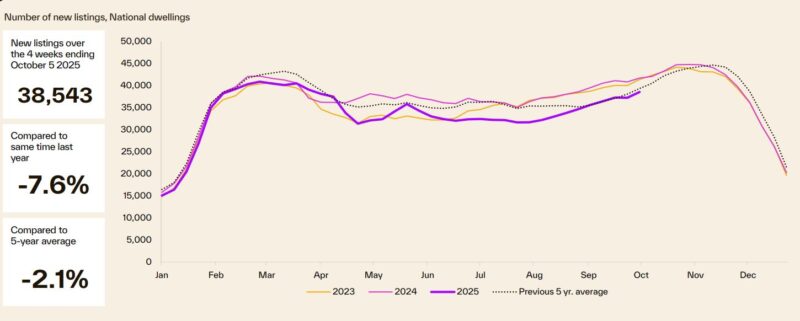
Vendor metrics
As the following chart shows, it's taking longer to sell a home.
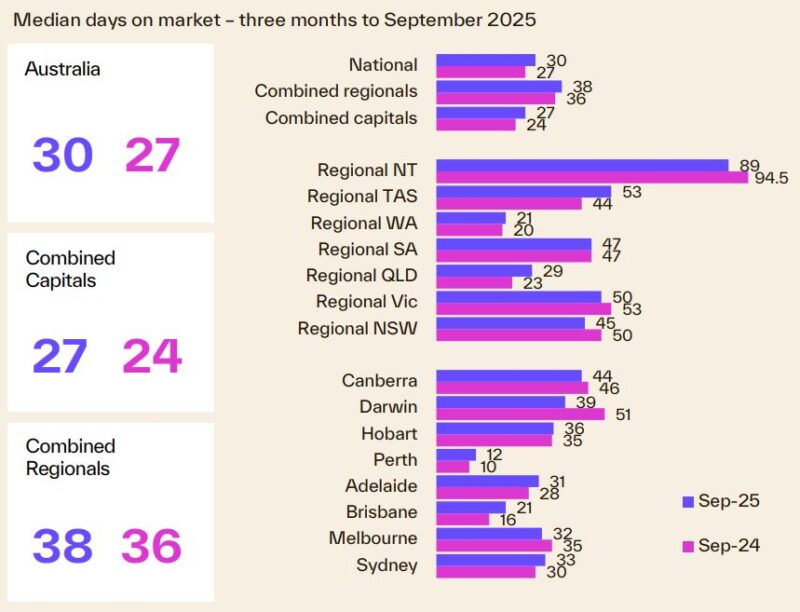
The amount of time it takes to sell a property by private treaty has increased year-on-year to 30 days nationally, but results vary depending on the market.
For example, the recent strength in the Darwin market has driven down selling times from 51 days in the September quarter last year to just 39 days.
In Melbourne, selling times have fallen from 35 to 32 days year-on-year. Sales volumes have also increased in these markets, which could be skewing the national figure.
